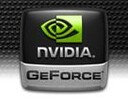Test Alienware Area-51 m17x Notebook
Intel Core 2 Duo T9500 | NVIDIA GeForce 8800M GTX SLI | 17.10" | 5 kg

Two Nvidia GeForce 8800M GTX cards are combined in SLI. With this setup, users should be able to play DirectX 10 PC games on high detail settings and resolutions. Nonetheless, not every game supports SLI efficiently. As a result, only an increase of 0-40% is obtainable over a single 8800M GTX, depending on the application and driver support. Overall performance should still be similar to a 9800M GT SLI combination.
A particular feature of the GeForce 8800M GTX SLI is Unified Shaders. Dedicated pixel and vertex shaders have been replaced with 2x96 Stream Processors, which have now taken over much of the graphics rendering work. The Shader units are also clocked higher than the core chip itself (1250 MHz versus 800 MHz).
The performance of an 8800M GTX in SLI is much better than an 8700M GT in SLI and even the GeForce 7950 GTX in SLI.
The current consumption (about 2x35 Watt TDP) and created heat of dual 8800M GTX cards are much higher compared to the 8700M GT in SLI. This reserves the 8800M GTX SLI setup for larger laptops with more powerful (and possibly louder) cooling solutions.
GeForce 8800M Series
| ||||||||||
| Codename | NB8E-GTX | |||||||||
| Architecture | G9x | |||||||||
| Pipelines | 192 - unified | |||||||||
| Core Speed | 500 MHz | |||||||||
| Shader Speed | 1250 MHz | |||||||||
| Memory Speed | 800 MHz | |||||||||
| Memory Bus Width | 256 Bit | |||||||||
| Memory Type | GDDR3 | |||||||||
| Max. Amount of Memory | 512 MB | |||||||||
| Shared Memory | no | |||||||||
| API | DirectX 10, Shader 4.0 | |||||||||
| Power Consumption | 130 Watt | |||||||||
| Transistor Count | 1.5 Billion | |||||||||
| technology | 65 nm | |||||||||
| Features | 1250 MHz Shader frequence, probably: PureVideo Technology (H.264, VC-1, MPEG2, WMV9 Decoder acceleration), HDCP-capable, PowerMizer 7.0 energy management (dynamic switching between performance and energy saving), HDR (High Dynamic-Range Lighting), designed for Windows Vista, Dual-Link DVI-D exits for resolutions of TFT up to 2560x1600, PCI-E 16x, OpenGL 2.1, Gigathread technology | |||||||||
| Notebook Size | large | |||||||||
| Date of Announcement | 19.11.2007 | |||||||||
| Information | 2 graphic cards combined by SLI | |||||||||
| Link to Manufacturer Page | www.nvidia.com | |||||||||
The following benchmarks stem from our benchmarks of review laptops. The performance depends on the used graphics memory, clock rate, processor, system settings, drivers, and operating systems. So the results don't have to be representative for all laptops with this GPU. For detailed information on the benchmark results, click on the fps number.
| low | med. | high | ultra | QHD | 4K | |
|---|---|---|---|---|---|---|
| Crysis - GPU Benchmark | 104 | 64 | 46 | |||
| Crysis - CPU Benchmark | 125 | 54 | 39 | |||
| World in Conflict - Benchmark | 64 | 39 | ||||
| Call of Juarez Benchmark | 40 | |||||
| The Elder Scrolls IV - Oblivion | 60 | |||||
| F.E.A.R. | 352 | 208 | 139 | |||
| Doom 3 | 142 | 142 | 140 | 138 | ||
| low | med. | high | ultra | QHD | 4K | < 30 fps < 60 fps < 120 fps ≥ 120 fps | 1 3 | 1 2 2 | 4 1 2 | 1 | | |
For more games that might be playable and a list of all games and graphics cards visit our Gaming List
The following Benchmarks are from our Dell XPS M1730 review. The notebook was equiped with a T7700, PhysX card, and 4 GB RAM.
Call of Duty 4: 1920x1200, high: 88 fps -> fully playable
Company of Heroes 1.7: 1024x768, high: 30 fps -> playable
World in Conflict: 1024x768, very high DX10: 25 fps (Benchmark) -> playable (with some stuttering)
Crysis: 1280x800, high: playable with stuttering (1024x768, high DX10: 35 fps)
Unreal Tournament 3: 1920x1200, max: 50 fps -> fully playable
Quake 4: 1920x1200, ultra: 60 fps -> fully playable
Age of Empires 3 - Asian Dynasties: 1920x1200, max (außer Footprints): 20-50 fps -> playable (sometimes the framerate broke down to 0)
Supreme Commander: 1024x768, high (Benchmark): 30 fps -> playable (smaller maps are playable with higher resolutions)
F.E.A.R.: 1600x1200, max (inkl AA): 56 fps -> fully playable
Doom 3: 1024x768, utra: 122 fps -> fully playable (in highest resolution)
Alienware Area-51 m17x: Intel Core 2 Duo T9500, 17.10", 5 kg
External Review » Alienware Area-51 m17x
» Comparison of GPUs
Detailed list of all laptop GPUs sorted by class and performance.
» Benchmark List
Sort and restrict laptop GPUs based on performance in synthetic benchmarks.
» Notebook Gaming List
Playable games for each graphics card and their average FPS results.
* Approximate position of the graphics adapter
Top 10 Laptops
Multimedia, Budget Multimedia, Gaming, Budget Gaming, Lightweight Gaming, Business, Budget Office, Workstation, Subnotebooks, Ultrabooks, Chromebooks
under 300 USD/Euros, under 500 USD/Euros, 1,000 USD/Euros, for University Students, Best Displays
Top 10 Smartphones
Smartphones, Phablets, ≤6-inch, Camera Smartphones